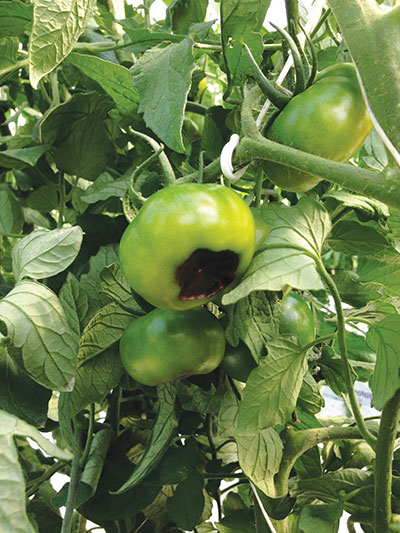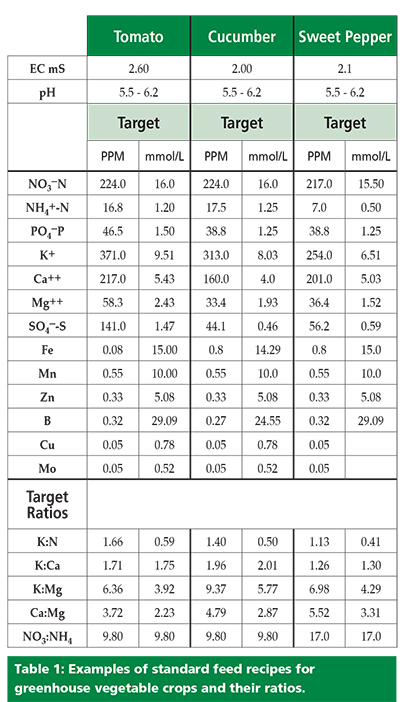
Maintaining a good nutrient balance in the rootzone can help avoid many common fruit quality disorders, such as blossom end rot (BER), blotchy ripening and micro-cracking.
 |
|
| Tomato with BER. Advertisement
|
Standard feed recipes are available from all analytical laboratories and with a regular analysis (preferably every week but minimally at least every 14 days) of the rootzone solution; the feed solution can be adjusted so that optimum nutrient ratios are maintained.
Examples of feed recipes for the most common greenhouse vegetable crops are provided in Table 1.
Nutrients and their ratio: A distinction should be made between the individual concentration of each element in the applied nutrient concentration (total feed EC), rootzone concentration (total substrate EC) and nutrient uptake concentration (uptake of nutri-
ents/uptake of water). The optimum concentration in rootzone for growth and development may not be the same as the uptake concentration.
K:Ca ratio (Potassium: Calcium): Keeping the K:Ca ratio in balance will help to avoid BER. In the summer, the K:Ca in the substrate should be 1:1 to 1:1.5. The reason why this balance is so important to avoid BER is simple: K+ is a monovalent ion whereas Ca2+ is a bivalent ion. In essence, this means that K+ is more readily available to the plant. When high levels are present, it can therefore compete and limit Ca2+ uptake. In this respect, also take note of the high levels of Na+ (sodium) which may build up in the rootzone when recycling drain water. Na+ is another antagonist to Ca2+.
As Ca2+ is transported upwards in the plant along with the transpiration stream, environmental factors which affect water uptake can also have an influence on Ca2+ uptake and distribution in plants.
It is also worthy to note that Ca2+ is absorbed actively through fine root hairs and therefore a strong healthy root system is very important. Maintaining a healthy root system can be achieved by a sound water management strategy, paying particular attention to start and stop times, especially in dark and or changeable weather.
In the first few weeks after planting, cucumber plants need extra Ca2+. During first harvest, K+ levels need increasing in order to avoid pale fruits. The recommendations are for four to six weeks, depending on the season and your location: K:Ca = 1.5, and then K:Ca = 2.0.
K:N ratio (Potassium: Nitrogen): Plants have different absorption rates for individual elements at various stages of growth and development.
For example, the nitrogen absorption by tomato plants during the formation of the first two to three flowering trusses is about the same as that of K+ (K:N = 1.2:1.0).
As the fruit load increases, so does the K+ uptake, resulting in a K:N ratio of 2:1. An excessive amount of N-NO3 during low light conditions can result in vegetative growth of the plant, which can increase the sensitivity to diseases, such as Botrytis, and quality problems, such as blotchy ripening, green shoulder and misshapen fruits.
Lowering the N-NO3 feed during this stage can help to control plant growth and make the plant more generative.
 |
IMPACT OF pH
The pH of a solution does not play a direct role on the fruit quality, but pH plays an important role as it influences the availability of nutrients.
Generally, micronutrients such as iron (Fe3+), manganese (Mn3+) and zinc (Zn2+) become less available as the pH is increased above 6.0, so it is always advisable to supply these elements in chelated form. At high pH levels, phosphate (H2PO4-) will also precipitate as insoluble calcium or magnesium phosphate, making phosphate unavailable to the crop as well as blocking the irrigation drippers.
A balanced uptake of each of the nutrient elements is only possible if the pH in the root zone is within the range of 5.5 to 6.5. The target pH for the drip solution on stone wool substrates should be 5.2 to 5.6. Never reduce the pH of the drip solution below 5.0; at these levels there is no more bicarbonate buffer and the pH can drop down to uncontrollable levels, and can cause damage to roots and substrate structure.
During cultivation, the pH in the rootzone will fluctuate. For example, with a greater uptake of negatively charged ions (anions), such as nitrogen, in response to strong vegetative growth, the pH will increase (become more alkaline) and can therefore also increase the risk for BER.
With a greater uptake of positively charged ions (cations), such as potassium, in response to a high fruit load, the pH will decrease (become more acidic). To regulate pH, it is important to maintain the correct balance between ammonium-N and nitrate-N (NH4+-N and
NO3–N).
SUMMARIZING THE ACTIONS TO PREVENT FRUIT PHYSIOLOGICAL DISORDERS
- Make a weekly nutrient analysis, especially if drain water is reused, and adjust input solution accordingly.
- In summer, it is wise to make an analysis of the irrigation water and compare if this is in line with the calculated irrigation water.
- Maintain a stable and sufficient rootzone EC during the day.
- Maintain root quality with a stable decrease in WC overnight (eight to 10 per cent).
- Keep the pH at recommended levels.
 |
|
Rens Muusers graduated from Wageningen University with a master’s degree in Plant Sciences specializing in greenhouse horticulture. He now lives in Ontario and provides advice on substrate choice and irrigation management to growers in Canada, the U.S. and Mexico.
Print this page